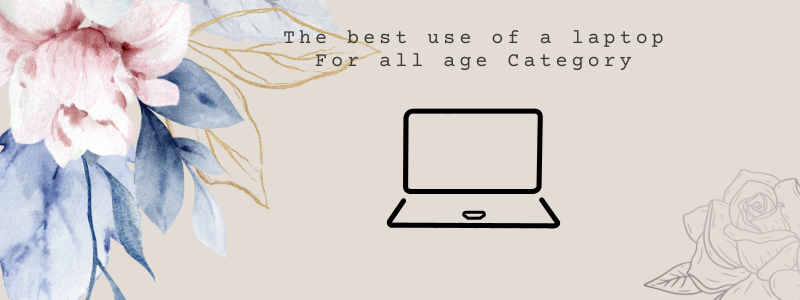Table of Contents

The best use of laptop
2025 The best use of a laptop today is inherently tied to its versatility and multifunctionality, allowing users to seamlessly transition between work, entertainment, communication, and creativity, all within a single device. A laptop is far more than just a portable computer; it has become an indispensable tool for productivity, learning, and leisure, transforming how we approach both personal and professional tasks.
In the realm of work, the laptop is a critical device for people in virtually every industry, offering the ability to perform high-level tasks such as writing, data analysis, project management, and even graphic design. For professionals in fields like software development, marketing, and business, the laptop provides the computing power necessary to run complex applications and multi-task across various programs. Whether it’s editing a report, attending virtual meetings, or handling multiple spreadsheets, laptops enable users to do all of this with mobility, offering the freedom to work from nearly any location.
This flexibility has particularly proven vital in the age of remote work, where laptops serve as the backbone for professionals who need to access their work files, communicate with teams across the globe, and maintain productivity from home or while traveling. Beyond just productivity, the laptop has become a vital tool for learning. Students at all levels, from elementary school to university, rely on laptops to access online courses, conduct research, and collaborate with peers. Educational platforms, digital libraries, and video lectures have transformed traditional learning environments, making knowledge accessible at the touch of a button. This access to information not only enriches the learning process but also allows individuals to learn at their own pace, in a manner that suits their schedules and learning styles. For those pursuing creative endeavors, the laptop is an essential instrument for graphic design, video editing, music production, and writing. Software like Adobe Creative Suite, Final Cut Pro, and various DAWs (Digital Audio Workstations) have turned the laptop into a mini studio, capable of producing professional-grade content. 2025 The best use of a laptop by Independent filmmakers, artists, musicians, and writers alike can use laptops to develop their craft and even distribute their work online, democratizing access to creative production in ways that were once reserved for those with significant resources. In addition to its work-related and educational uses, the laptop serves as a hub for communication. With the rise of video conferencing tools like Zoom, Skype, and Microsoft Teams, laptops have become the bridge for personal and professional connections that span across continents. Social media platforms, email, instant messaging, and even virtual reality applications all rely on laptops as a primary interface for staying in touch with friends, family, and colleagues, further enhancing the sense of global connectivity. Furthermore, the entertainment aspect of laptops has made them indispensable in everyday life. Streaming services like Netflix, YouTube, and Spotify have turned laptops into entertainment centers, enabling users to watch movies, listen to music, and even play video games with remarkable graphics and performance. Many modern laptops are equipped with high-definition displays, powerful processors, and discrete graphics cards, making them excellent for gaming and media consumption. For gamers, laptops now offer a portable solution without sacrificing the level of detail and performance found in desktop gaming setups. Furthermore, the ability to access a vast library of games, apps, and multimedia content via the internet has transformed laptops into hubs for personal entertainment. In terms of personal convenience, laptops have revolutionized everyday tasks, such as managing finances, shopping online, and booking travel arrangements. As we look toward the future, the potential for laptops to continue expanding their role in daily life is boundless. The development of more energy-efficient systems, enhanced connectivity options like 5G, and the integration of emerging technologies such as augmented reality (AR) and virtual reality (VR) could further redefine how we use laptops in our everyday lives. With an ever-growing reliance on technology, the laptop’s ability to adapt to a variety of tasks and its portability ensure that it will remain a dominant tool for the foreseeable future, making it the best device to meet the diverse needs of users across all walks of life. Whether for work, education, creativity, communication, or entertainment, the laptop stands as a quintessential piece of technology, perfectly balancing practicality with performance in an increasingly digital world.
The use of cloud-based tools has also made it easier to store, share, and access data across multiple devices, allowing users to keep their information synchronized and secure. Laptops have also become indispensable for casual browsing and staying connected to the ever-evolving world of news, social media, and current events. Thanks to their portability and user-friendly design, laptops have made it possible to integrate a wide range of activities into a single device, creating a seamless experience where work and play are no longer confined to separate spaces.
2025 The best use of a laptop beat use of a Laptops have allowed for an increasing number of individuals to work from virtually anywhere, offering a balance between flexibility and productivity. Additionally, with the integration of artificial intelligence (AI) and machine learning capabilities into modern laptops, the device has gained even greater efficiency. Laptops are now capable of predictive functions, smart assistance, and automating routine tasks. For instance, AI-driven programs can help users streamline their workflow, offer insights for better decision-making, and even enhance user experience through personalized recommendations in media consumption, productivity tools, or even lifestyle choices.
2025 The best use of a laptop Even in unexpected ways, the laptop shows its value. During global crises, it becomes the pulse of continuity—offering education when schools close, connection when borders shut, and purpose when days feel uncertain. Artists use it to share their truth, scientists to crunch life-saving data, teachers to reach eager minds, and everyday people to find solace in stories and songs. It allows revolutions to begin in small rooms, and ideas to travel faster than ever before. In every corner of the world, a laptop sits quietly on a desk or a lap, offering the same invitation to think, learn, express, and connect. The best use of a laptop, therefore, is not defined by age or title, but by imagination. Whether used to send a single email that changes a life or to write lines of code that change the world, its worth is shaped by the heart and mind behind the screen. It is not just a tool of the present—it is a companion into the future, evolving with us, and forever ready to help us turn thought into action and dreams into reality.
2025 The best use of a laptop is to make life easier, smarter, and more connected. It helps people learn, work, create, and stay in touch with others. For students, a laptop is a digital classroom. They can take notes, attend online classes, and research topics quickly. For professionals, it is a mobile office. They can send emails, join meetings, and complete tasks from anywhere. Creative people use laptops to design, write, edit videos, or make music. For older adults, it offers a way to connect with family, watch movies, and read news. Even kids can use laptops for learning games and fun activities. Laptops help people of all ages grow, express themselves, and stay informed. Whether used for study, work, or entertainment, a laptop is a helpful tool that fits into everyday life.

👶 For Children (Ages 5–12)
- Educational Games & Apps: Fun learning through interactive platforms like ABCmouse or Khan Academy Kids.
- Watching Educational Videos: Safe content on YouTube Kids or PBS Kids.
- Creative Activities: Drawing with paint apps, music games, and story writing.
🧒👧 For Teenagers (Ages 13–19)
- Studying & Homework: Researching online, typing essays, and using tools like Google Docs or Notion.
- Online Learning: Taking courses on platforms like Coursera or Udemy.
- Entertainment: Watching movies, listening to music, playing games.
- Creative Projects: Coding, video editing, graphic design, or blogging.
👨🎓👩🎓 For College Students
- Note-taking & Research: Using Word, OneNote, Zotero, or Google Scholar.
- Project Collaboration: Google Drive, Zoom, Slack, or Trello.
- Online Classes: Joining virtual lectures or MOOCs (Massive Open Online Courses).
- Personal Growth: Learning skills like programming, writing, or digital art.
👨💼👩💼 For Working Adults
- Work From Home: Attending meetings, sending emails, managing projects.
- Freelancing & Business: Using design tools, managing social media, creating spreadsheets.
- Online Banking & Shopping: Managing finances and ordering essentials.
- Professional Development: Taking career-boosting online courses or certifications.
👴👵 For Elderly People
- Communication: Video calls, emails, and chatting with family.
- Health Management: Telemedicine, medication reminders, health tracking.
- Entertainment: Watching shows, listening to music, reading news or eBooks.
- Mental Engagement: Playing puzzle games, learning new things, and staying informed.

🛠️ Universal Uses for All Ages
- Internet Browsing: For knowledge, fun, and communication.
- Document Creation: Writing, editing, or keeping records.
- Cloud Storage: Backing up photos, files, and important information.
- Security & Privacy: Managing digital identities and passwords.
In an age where technology shapes the rhythm of our lives, the laptop stands out as a silent companion that adapts effortlessly to the needs of people across generations. It isn’t just a machine—it’s a personal gateway to learning, connection, creation, and convenience. From the playful curiosity of children to the thoughtful reflection of the elderly, the best use of a laptop evolves with age, offering something meaningful for everyone. For young children, a laptop can be a magical doorway to imagination and discovery. With the right supervision and guidance, kids can explore interactive educational platforms that turn math into a game, science into an adventure, and reading into a digital storybook. Bright visuals, engaging sounds, and gamified learning help children absorb knowledge without pressure. They can paint with digital brushes, build virtual worlds, or even learn basic coding through colorful block programming—all while developing early digital literacy that will serve them for life. As these children grow into teenagers, the laptop transforms into a tool of identity and self-expression. Teens use it not just to complete schoolwork, but to find their voice. Whether it’s editing a video, writing a blog, starting a small online business, or simply learning a new skill on YouTube, the laptop empowers teenagers to create, explore, and define who they are outside the classroom. At the same time, it’s a bridge between friends and a tool for managing their increasingly complex academic and social lives. Researching for school projects, collaborating on assignments in real time, or attending virtual classes—all of it becomes second nature.
For university students, the laptop becomes almost an extension of the brain. It’s where notes are typed, assignments are crafted, resumes are built, and late-night study sessions are powered by tabs filled with research papers and caffeine-fueled determination. It holds a student’s academic life, social calendar, internship applications, side hustles, and sometimes even their dreams. Many students learn to code, design, edit, and freelance using just their laptops, building careers even before graduation. It’s not uncommon for a single laptop to become the launchpad for a student’s future business, art portfolio, or software project. The flexibility to attend online courses, join webinars, access digital libraries, and connect with global communities ensures that learning never stops and inspiration is always a click away. For working adults, the laptop is their mobile office, creative studio, or command center. It enables remote work, digital collaboration, and uninterrupted productivity, no matter where they are. A marketing executive can pitch to clients over video calls, a software engineer can build an app from a café, a teacher can conduct virtual lessons from home, and a writer can draft a novel at midnight. Beyond work, adults use laptops to manage finances, plan travel, learn new languages, and even launch online businesses. They are tools of independence and empowerment, helping individuals balance careers, passions, and personal responsibilities in a fast-paced world.
And yet, perhaps the most heartwarming use of laptops is among the elderly, many of whom have embraced digital life with admirable curiosity and courage. For seniors, a laptop is more than just a screen—it’s a lifeline to the people and world they love. It allows them to see the faces of grandchildren living miles away, to join in family celebrations through video calls, and to scroll through photos that bring smiles and tears. But it doesn’t stop there. Elderly users are now attending virtual yoga classes, watching documentaries, playing chess online, or even learning new hobbies like baking or painting through tutorial videos. With increasing access to telehealth, they can now consult doctors, refill prescriptions, or read about health conditions without leaving home. Customizable settings like larger text, screen readers, and simplified interfaces make laptops more senior-friendly, proving that age is no barrier to embracing digital life. The beauty of the laptop lies in its adaptability—it meets you where you are. It listens quietly to your needs and offers just the right set of tools to enrich your world, whether you’re solving algebra, closing business deals, writing poetry, or simply catching up on the news.
But beyond age-specific uses, there are universal benefits of laptops that tie all generations together. Laptops provide access to the infinite well of knowledge available online—libraries, tutorials, blogs, and forums that make anyone a student of anything. They support communication, shrinking distance and time zones with instant messages and video calls. They enable creativity—whether that means composing music, editing photographs, or crafting digital art. They also help us stay organized, manage schedules, set reminders, and track goals. In times of global crises or personal transitions, laptops keep people informed, connected, and resilient. They bridge the gap between tradition and technology, allowing grandparents to learn about their culture while their grandchildren remix it into a TikTok video. And most importantly, they foster independence—because whether you’re learning to type your first word or mastering a new programming language, doing it on your own laptop gives you the freedom to grow at your own pace.
The best use of a laptop isn’t just in what it can do, but in how it empowers us to do more. It’s not defined by brand or specs, but by how it fits into the life and purpose of its user. For some, it’s a lifeline to education; for others, a passport to opportunity; for many, it’s a journal, a sketchbook, a classroom, or even a stage. In every case, it is a mirror that reflects the endless potential of its user. Whether used to send a heartfelt email, design a world-changing innovation, or simply enjoy a good book on a quiet evening, a laptop has the quiet power to make lives easier, richer, and more connected. And that is its greatest use: not just as a machine, but as a companion through every stage of life.
- Education & Learning
- Attending online classes (Zoom, Google Meet)
- Watching educational videos (YouTube, Khan Academy)
- Using eBooks and research tools (Google Scholar, PDFs)
- Taking notes and organizing assignments (OneNote, Google Docs)
- Work & Productivity
- Writing documents, making presentations, analyzing data
- Managing emails, scheduling, and virtual meetings
- Working remotely or freelancing from anywhere
- Creativity & Hobbies
- Digital art, graphic design, photo editing
- Music production or video editing (GarageBand, Canva, Adobe Premiere)
- Blogging, vlogging, or writing stories
- Communication & Connection
- Video calling with friends and family
- Social media platforms for networking
- Messaging apps (WhatsApp Web, Messenger)
- Entertainment
- Watching movies or series on Netflix or YouTube
- Playing games or streaming music
- Reading digital books or news
- Health & Lifestyle
- Tracking health appointments
- Using meditation or wellness apps
- Telemedicine and online consultations
- Personal Development
- Learning new skills (language apps, coding platforms)
- Taking online courses (Coursera, Udemy)
- Building resumes and job applications
- Daily Life Tasks
- Online banking and bill payments
- Grocery shopping and ordering essentials
- Planning with digital calendars and reminders
